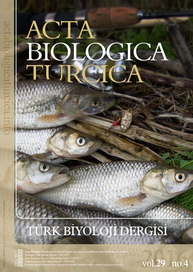Turkish blanket bogs and Sphagnum (Bryophyta) diversity of these blanket bogs
Abstract
Ombrotrophic bogs (called raised/blanket bogs), which are one of the special habitats that host bryophytes, are acidic and poor in mineral salts, and very limited numbers of organisms can cope with such extreme conditions. There are very limited blanket bogs in Turkey such as the Ağaçbaşı Peatland, Barma Yaylası Peatland, Yılanlıtaş Yaylası Peatland (Trabzon), Kabaca–Petek Yaylası Peatland, Sazak Peatland (Artvin) and Ciğer Gölü Peatland (Çanakale). Except the Ciğer Gölü Peatland, all of them are located at the north-eastern part of Turkey. Among them Yılanlıtaş Yaylası and Ciğer Gölü are almost extinct. Although the diversity of moss on peatlands is poor, Sphagnum is the most known and remarkable taxon of these areas. A total of 21 taxa belong to genus Sphagnum were collected from these peatlands. S. subsecundum, S. platyphyllum, S. nemoreum, S. girgensohnii, S. compactum, S. centrale and S. angustifolium were found as the most common taxa.
Keywords
Full Text:
PDFReferences
Abay G., Keçeli T. 2014. Sphagnum molle (Sphagnaceae, Bryophyta) in Turkey and SW Asia, Cryptogamie, Bryologie, 35(1): 105-112.
Abay G., Uyar G., Keçeli T., Çetin B. 2009. Sphagnum centrale and other remarkable bryophyte records from the Kaçkar Mountains (Northern Turkey), Cryptogamie Bryologie, 30: 399-407.
Avcı M. 2005. Çeşitlilik ve Edemizim Açısından Türkiye’nin Bitki Örtüsü, Coğrafya Dergisi, 13: 27-55.
Aytuğ B., Merev N., Edis G. 1975. Sürmene-Ağaçbaşı Dolayları Ladin Ormanlarının Geleceği ve Tarihi, Tubitak Tar. ve Or. Araş. Grubu Ya., No.39. Ankara.
Boatman D.J. 1983. The Silver Flowe National Nature Reserve, Galloway, Scotland. Journal of Biogeography, 10: 163-274.
Crum H.A. 2001. Structural Diversity of Bryophytes. The University of Michigan Herbarium, Ann Arbor, MI, pp. 379.
Çolak AH, Günay T 2011. Turbalıklar ( Mire/Peatland-Moore). T.C. Orman ve Su İşleri Bakanlığı Batı Karadeniz Ormancılık Araştırma Enstitüsü Müdürlüğü-Bolu. pp. 471.
EC 2007. European Commission. Interpretation manual of European Union habitats. EUR 27, DG Environment, Nature and Biodiversity.
Grandstein S.R., Griffin D., Morales M.I., Nadkarni N.M. 2001. Diversity and habitat differentiation of mosses and liverworts in the cloud forest of Monteverde, Costa Rica, Caldasia, 23: 203-212.
Handel – Mazzetti H. M. 1909. Ergebnisse einer botanische Reise in des Pontische Randgebirge in Sandschak Trapezunt, Ann. Nathist. Hofmus. Wien, 23: 124-212.
Henderson D.M. 1961. Contribution to the bryophyte flora of Turkey: V: Summary of Present Knowledge Notes Roy. Bot. Gard, Edinburg, 10: 279-301.
Henderson D.M., Prentice H.T. 1969. Contributions to the bryopyte flora of Turkey:VIII”, Notes Roy. Bot. Gard. Edinburgh, 29: 235-262.
Irmak A. 1968. Toprak ilmi. İ.Ü. Orman Fak. Yay. No.121, İstanbul.
Joosten H., Couwenberg J. 2008. Peatlands and Carbon. In: Parish, F. et al. Assessment on peatlands, biodiversity and climate change. Global Environment Centre, Kuala Lumpur and Wetlands International Wageningen, pp. 99-117. Kayacık, H., 1956. Amanos Dağlarında Lokal Turbalık Teşekkülleri ve Bunların Florası Üzerinde Araştırmalar, Journal of the Faculty of Forestry, 6 (1): 108-113.
Kirmaci M., Kürschner H. 2013. The genus Sphagnum L. in Turkey – with S. contortum, S. fallax, S. magellanicum and S. rubellum, new to Turkey and Southwest Asia, Nova Hedwigia, 96 (3-4): 383-397.
Kirmaci M., Kürschner H. 2017. New national and regional bryophyte records 50 “Sphagnum tenellum (Brid.) Brid. (Ed. L.T. Ellis), Journal of Bryology, 39(1): 99-114.
Lindsay RA, Charman DJ, Everingham F, O’Reilly RM, Palmer MA, Rowell TA, Stroud DA 1988. The flow country: the peatlands of Caithness and Sutherland Technical Report Nature Conservancy Council, Peterboroug. Pp. 163.
Louıse H. 1939. Das naturliche Pflanzenkleid Anatoliens. Geographisch Gesehen Stuttgart. 74.
Moore T.R., Dalva M. 1993. The influence of temperature and water table position on carbon dioxide and methane emissions from laboratory columns of peatland soils, Journal of Soil Science 44: 651-664.
O’ Connell M. 1990. Origins of lowland Irish blanket bog. In: Doyle, G.J. (ed.) Ecology and Conservation of Irish Peatlands, pp. 49-71, Royal Irish Academy, Dublin.
Öner Ş. 2009. Vegatation History and Human Activity in 2nd millennium AD in NW Turkey: Pollen Analysis of a peat bog. Ann. Bot. Fennici, 46: 192-200.
Ören M., Uyar G., Ezer T., Gözcü M. C. 2017. New and noteworthy bryophyte records for Turkey and Southwest Asia Telopea Journal of Plant Systematics, Volume 20: 97–104.
Payne R., Eastwood W., Charman D. 2007. The ongoing destruction of Turkey’s largest upland mire, IMCG Newsletter, 1, 5–6.
Robinson H., Godfrey R.K. 1960. Contributions to the Bryophyte Flora of Turkey, Revue Bryologique et Lichènologique, 29: 244–253.
Schiffner V. 1896. Ueber die von Sintenis in Türkisch-Armenien gesammelten Kryptogamen, Österr. Bot. Zeitschr., 46: 274-278.
Strack M. (ed) 2008. Peatlands and Climate Change, International Peat Society and Saarijärven Offset Oy, Finland. Pp. 211.
Tonguç Yayıntaş Ö. 2013. New moss records from western part of Turkey, Bangladesh Journal of Botany, 42: 371–375.
Walther K. 1967. Beitrage zur Moosflora Westanatoliens I., Mitt. Staatsinst, Allg. Bot. Hamburg, 12: 129-188.
Wheeler B.D., Shaw S.C. 1995. Restoration of Damaged Peatlands. Department of the Environment, HMSO, London, UK.
URL 1, http://www.mgm.gov.tr/veridegerlendirme/yagis-raporu.aspx#sfU [Accessed: 2018-10-28]
URL 2, https://www.mgm.gov.tr/FILES/resmi-istatistikler/Turkiye-Ortalama-Sicaklik.pdf [Accessed: 2018-10-28]
URL 3, https://www.mgm.gov.tr/FTPDATA/veri-degerlendirme/referans-toplam-buharlasma/ETo_toplam.jpg [Accessed: 2018-10-28]
Refbacks
- There are currently no refbacks.

